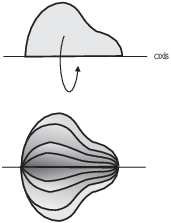
Start with an area --- a planar region --- which you can imagine as a piece of cardboard. The cardboard is attached by one edge to a stick (the axis of revolution). As you spin the stick, the area revolves and sweeps out a region in space.

The problem is to find the volume of revolution --- the volume of the region in space which is swept out by the area.
If the region is like the one above, you can find its volume by cutting the region into circular slices perpendicular to the axis.

(We'll have to make some adjustments if there is space between the area being revolved and the axis.)
If the radius of a slice is r, then its volume is
![]()
In the simplest case, the radius is given by a nonegative function
![]() , and the volume is generated by revolving
the area under the graph of f from
, and the volume is generated by revolving
the area under the graph of f from ![]() to
to ![]() around the x-axis. As usual,
I divide the interval
around the x-axis. As usual,
I divide the interval ![]() up into
pieces, with the k-th piece having width
up into
pieces, with the k-th piece having width ![]() . I pick an x-value in the k-th piece, say
. I pick an x-value in the k-th piece, say
![]() . Then the volume of the k-th circular
slice will be
. Then the volume of the k-th circular
slice will be
![]()
The total volume is approximated by adding up the volumes of the slices, as you can see in the picture above. So if I have n slices, then
![]()
To get the exact volume, I shrink the slices, letting the thickness
![]() of a typical slice go to 0:
of a typical slice go to 0:
![]()
The expression on the right is a Riemann sum for ![]() . So
. So
![]()
We get a similar expression if the area is revolved about the y-axis.
As with area problems, I'll use a shortcut rather than writing down the Riemann sum. I'll simply write
![]()
In the examples I do, the axis of revolution will always be parallel
to the x-axis or the y-axis. If the axis is parallel to the x-axis,
the thickness is ![]() ; if the axis is
parallel to the y-axis, the thickness is
; if the axis is
parallel to the y-axis, the thickness is ![]() . These correspond to
. These correspond to ![]() or
or ![]() in the Riemann sum.
in the Riemann sum.
The radius r is the distance from the axis of revolution to the edge of the slice. It will usually be given by a function specified in the problem which determines the region which is being revolved. You'll see how this works in the examples below.
Example. The region under ![]() from
from ![]() to
to ![]() is revolved about the x-axis. Find the
volume generated.
is revolved about the x-axis. Find the
volume generated.
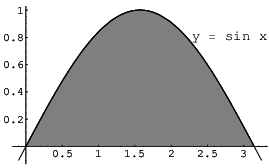
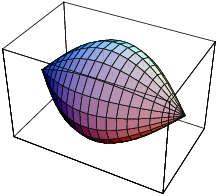
To find the volume, cut the solid into circular slices perpendicular to the axis:
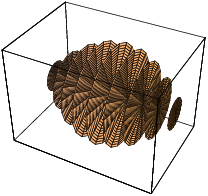
The radius of a typical slice is the height of the curve: ![]() . The thickness is
. The thickness is ![]() . Thus, the volume of a typical slice is
. Thus, the volume of a typical slice is ![]() --- (circle area) times
(thickness). So the total volume is
--- (circle area) times
(thickness). So the total volume is
![]()
I used the double angle formula for ![]() to compute the antiderivative.
to compute the antiderivative.![]()
Example. The area bounded by ![]() and the x-axis is revolved about the
x-axis. Find the volume of the solid generated.
and the x-axis is revolved about the
x-axis. Find the volume of the solid generated.
The region is the area under the parabola ![]() from
from ![]() to
to ![]() .
.
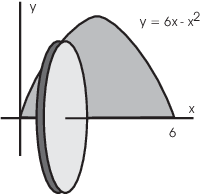
In the picture above, I've superimposed a typical slice over the
picture of the area being revolved. You can see that the radius of a
typical slice is the height of the curve: ![]() . The thickness of a typical slice is
. The thickness of a typical slice is ![]() .
.
Thus, the total volume is
![]()
Example. Show that the volume of a sphere of
radius a is ![]() .
.
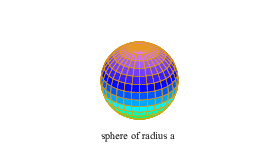
The equation of the circle of radius a centered at the origin is
![]()
The idea is to revolve the area under the top half of the circle around the x-axis to generate the sphere. The equation of the top half is
![]()
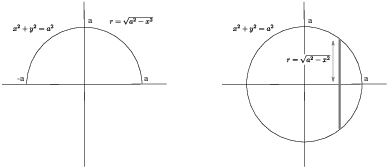
I'll use circular slices. A typical slice has radius ![]() . The volume is
. The volume is
![]()
Copyright 2019 by Bruce Ikenaga